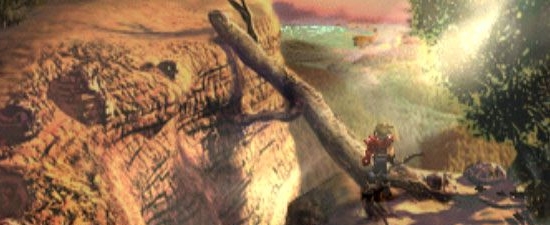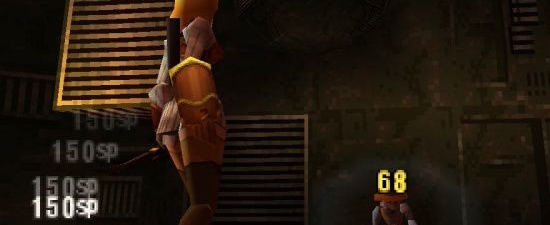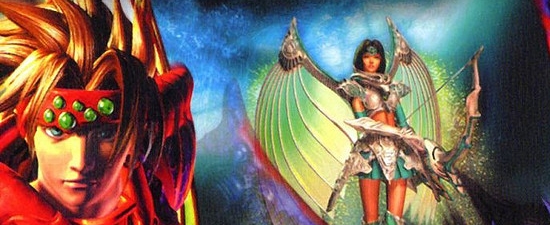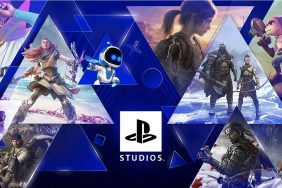PlayStation Classics Corner is a new series on PSLS dedicated to modern reviews of PlayStation Classics released on PSN.
About the game:
Legend of Dragoon is a PS1 JRPG from 2000, developed by a massive team at Sony Computer Entertainment, Inc. over a period of three and a half years. It launched as a PS1 Classic in North America on May 21, 2012 for $6 and is currently playable on PSP, PS3 and Vita. It currently isn’t officially supported on the Vita, but it is transferable to the Vita if downloaded on a PS3. It works flawlessly on the Vita, in fact I feel it is the optimal platform for experiencing the game.
“Hey, your disturbing my moment here!! You’re gonna pay for this!!” “Because you will die now in here!”

Legend of Dragoon begins with the protagonist, Dart Feld, returning to his hometown, Seles, after spending a few years unsuccessfully hunting down a mysterious Black Monster that killed his parents and destroyed his city of birth, Neet. When he arrives he finds that Sandora, one side to a civil war (with Serdio as its opposition), has destroyed Seles and kidnapped his childhood friend, Shana, who he must go rescue. This is only the start of his journey, which at first glance looks like an off-brand Final Fantasy, but in time forms its own distinct identity. The story is full of twists and turns, with quite a bit of character development and some genuinely moving moments.
There are nine total playable characters in the game, with three usable at once in battle and a maximum of seven in the party at any given time. Most of the characters fit a standard JRPG trope, like a monk, a giant, a member of royalty and a dark character with a secret past, but their personalities and backstories absolutely make up for it. Thankfully, players don’t have to be on the world map (a series of connected hubs) or at a save point to swap out characters as it can be done at any point where the menu is accessible.
Combat is turn-based and initiated after a certain amount of travel over unsafe land; random-battle areas are rare, with an arrow normally above Dart’s head going from green to yellow to red to let players know when to expect battle. Legend of Dragoon takes the timing of Squall’s gunblade attacks from Final Fantasy 8 or of pretty much any attack in the Mario RPG games and applies it to nearly every aspect of its combat mechanics. The vast majority of attacks aren’t just one-offs, they’re supplemented with combos called Additions. Players must time out presses of the X button (and occasionally the O button, to prevent counter-attacks) when prompted to perform their full combo, and each successful strike generates SP. Characters level up with XP like most other RPGs, but successful combo performance level up the SP gain and/or damage of that Addition combo. Characters gain new Additions with experience and can swap them out in the menu. Having to constantly time out button presses for successful attacks makes the Additions system feel somewhat annoying at times, but it is absolutely successful at keeping players attentive and rewarding their input.
With Dragoon in the game’s title, it is only natural that they’d be a huge part of the gameplay. SP gained from dealing Addition attacks are used to build up their SP meters, allowing the characters to turn into a dragoon and deal powerful elemental attacks or cast magic. There are levels to the meter, with each time it is filled giving one more turn as a dragoon. When all characters have maxed out their SP meters, they can perform a special ability that turns them all into dragoons at once. The character that begins this phase automatically performs perfect dragoon attack combos (which normally require charging through another timing-based mechanic) until they’re powered down, but the other characters see no benefit.

The item system diverges from the norm by putting a limit of only 32 attack or healing items at any given time. Weapons, armor and accessories are given their own bag with 255 slots, but I found myself wishing for more item space often in my playthrough. Luckily, healing and attack items are potent, for instance healing half a character’s health or dealing a fair amount of damage from the start of the game all the way to the end, and they’re very cheap at stores. This makes up for the item slot limitation, but it’s definitely something to consider when going in. Weapons, armor and accessories are the big money-hogs of the game, costing thousands of gold while items generally only cost 10 or 50 gold. Unfortunately, characters can’t use items while in their dragoon form, so when two of my characters are massacred by a boss and the one left standing is in dragoon form for four more turns… well, try to avoid being in dragoon form for more than two or three turns during hard boss fights, as a general rule of thumb. Having to repeat sections of the game because it restarts when you get a game over is a fun-sucking nuisance.
Overall, the game is very pretty by PS1 standards – it stands tall against any of Square Enix’s masterpieces of the era, with some lovely pre-rendered environments and character models with nice detail, especially during combat sequences. The game was promoted as having many CG cutscenes, but they weren’t spread evenly throughout the game: there actually aren’t many in the first two discs, but they pop up frequently in the latter two discs. SCEI put a ton of in-game cutscenes in the game, rendered with the more detailed combat character models; they usually pop up during, before or after boss fights and are animated very well, with nice visual effects accompanying them.
There are 60 Stardust items hidden throughout the game. For every five found, the player gets an item from a character named Martel, and if the player finds all of them they’re treated to a legendary hidden boss battle. I recommend players just casually look around for Stardust on their first playthrough, then consult a guide to find each one their second time through for an optional super-boss battle. There aren’t many side-missions, and one on a certain cursed boat in particular is lengthy and frustrating, with lots of backtracking, but the payoff item makes it all feel worthwhile.
The music in Legend of Dragoon ranges from subpar to spectacular, with the cheesy intro music grating on the ears every time a game loads, but most of the environment and battle music setting the tone well. I wouldn’t listen to most of the music outside of the game, as I do with many game soundtracks that rock, but there are a few city/town/field songs I’ve added to my playlist of ambient music. It’s not all good, but the great music more than makes up for the meh.

Sadly, the developers decided to put some voice acting in the game and it’s all terrible. Characters obnoxiously call out the name of their attack after a successful Addition combo or magic cast, and during CG cutscenes there’s often narration. It all sounds awkward and unnecessary, and the voices don’t always fit the characters, even if SCEI intended it to be groundbreaking. Worse yet, the game’s translation is lacking. It’s more than serviceable, but also more than noticeable. Prepare to re-read several lines of dialog to try to decipher their meaning, only to realize that the confusion was all due to simple grammatical errors. The inconsistency is enough to drive a moderate grammar Nazi like myself mad. It is enough to dull the impact of the dialog considerably, but not enough to ruin the message.
Legend of Dragoon is a long, rewarding JRPG that I highly recommend this to any fan of PS1 RPGs, especially those with a soft spot for the Final Fantasy series; however, expect to be turned off by the feeling that it’s “off-brand” before it starts to show its greatness, and beware its disappointing translation and voice acting.
-
Nice art style with lots of detail and variety, technically impressive for its time
-
Combat mechanics succeed at keeping players alert
-
Characters and story see a ton of development
-
Sub-par translation, voice acting is hard on the ears
-
Takes a while to really get going








